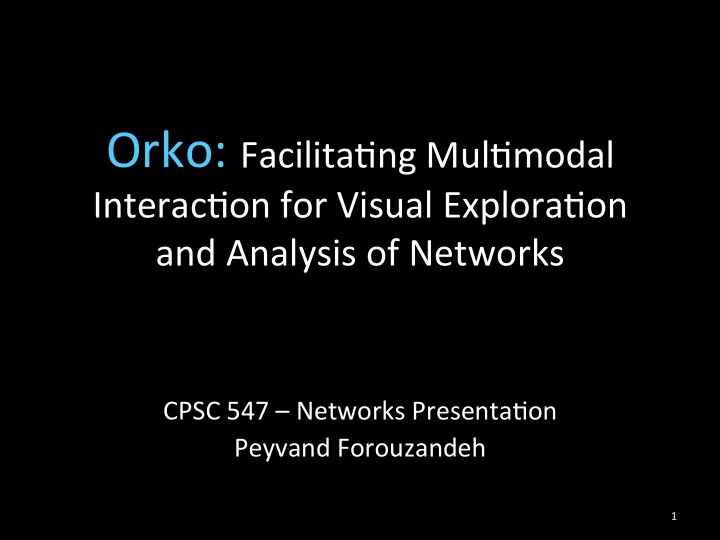

Orko: ¡ Facilita-ng ¡Mul-modal ¡ Interac-on ¡for ¡Visual ¡Explora-on ¡ and ¡Analysis ¡of ¡Networks ¡ CPSC ¡547 ¡– ¡Networks ¡Presenta-on ¡ Peyvand ¡Forouzandeh ¡ 1 ¡
What ¡is ¡Mul-modal ¡Interac-on? ¡ Using ¡two ¡or ¡more ¡modes ¡of ¡input/output ¡ ¡ Different ¡combina-ons: ¡ ¡ – Touch ¡and ¡speech ¡ – Movement ¡and ¡gaze ¡ ¡ – Gestures ¡and ¡gaze ¡ – Pen ¡and ¡touch ¡ – … ¡or ¡various ¡combina-ons ¡of ¡these ¡ 2 ¡
What ¡is ¡Mul-modal ¡Interac-on? ¡ Using ¡two ¡or ¡more ¡modes ¡of ¡input/output ¡ ¡ Different ¡combina-ons: ¡ ¡ – Touch ¡and ¡speech ¡ – Movement ¡and ¡gaze ¡ ¡ – Gestures ¡and ¡gaze ¡ – Pen ¡and ¡touch ¡ – … ¡or ¡various ¡combina-ons ¡of ¡these ¡ 3 ¡
Data ¡visualiza-on ¡user ¡interfaces ¡ • WIMP-‑based ¡direct ¡manipula-on ¡interfaces ¡ • ¡Post-‑WIMP ¡systems ¡ 1. Touch ¡input ¡ 2. Natural ¡language ¡interfaces ¡(NLIs) ¡ 4 ¡
Data ¡visualiza-on ¡user ¡interfaces ¡ • WIMP-‑based ¡direct ¡manipula-on ¡interfaces ¡ • ¡Post-‑WIMP ¡systems ¡ 1. Touch ¡input ¡ 2. Natural ¡language ¡interfaces ¡(NLIs) ¡ 3. ¡Mul-modal ¡interac-on ¡ 5 ¡
Combina-ons ¡of ¡input ¡modali-es ¡ Individual ¡ Sequen-al ¡ Simultaneous ¡ 6 ¡
Challenges ¡and ¡complexi-es ¡in ¡ interpre-ng ¡NLIs ¡ • Mul-ple ¡interpreta-on ¡ • Different ¡ways ¡to ¡ask ¡the ¡same ¡query ¡ • Ambiguity ¡ – Syntac-c ¡level ¡ – Seman-c ¡level ¡ 7 ¡
Possible ¡query ¡types ¡ • Explicit: ¡ ¡ Opera-ons ¡and ¡targets ¡are ¡specified ¡(sufficient ¡ tasks ¡and ¡values ¡informa-on) ¡ • Follow-‑up ¡and ¡contextual: ¡ Follow-‑up ¡to ¡the ¡previous ¡ queries ¡or ¡ac-ons ¡(typically ¡lack ¡references ¡to ¡tasks ¡or ¡values ¡ associated ¡with ¡the ¡task) ¡ • High-‑level: ¡ open-‑ended ¡ques-ons; ¡mul-ple ¡opera-ons ¡ combined ¡together ¡ ¡ 8 ¡
System ¡architecture ¡ Two ¡step ¡approach ¡parser: ¡ 1. Grammar ¡parser ¡ 2. Lexicon ¡parser ¡ 9 ¡
Combina-ons ¡of ¡input ¡modali-es ¡ 1. The ¡context ¡generated ¡by ¡one ¡input ¡is ¡used ¡to ¡complement ¡ the ¡second ¡and ¡highlight ¡connec-ons ¡of ¡the ¡filtered ¡nodes ¡ Input ¡1 ¡ Generated ¡ context ¡ Input ¡2 ¡ 2. The ¡system ¡processes ¡the ¡two ¡inputs ¡individually, ¡preserving ¡ filters ¡from ¡the ¡spoken ¡query ¡ Input ¡1 ¡ Context ¡ 10 ¡ Input ¡2 ¡
Afributes ¡and ¡connec-ons ¡ 11 ¡
Orko ¡ hfps://vimeo.com/238502489 ¡ 12 ¡
Orko’s ¡user ¡interface ¡ A: ¡Natural ¡language ¡input ¡and ¡ac-on ¡feedback ¡ ¡ 13 ¡
Orko’s ¡user ¡interface ¡ B: ¡Ac-on ¡feedback ¡ ¡ 14 ¡
Orko’s ¡user ¡interface ¡ C: ¡Network ¡Canvas ¡ 15 ¡
Orko’s ¡user ¡interface ¡ D: ¡Quick ¡access ¡icons ¡ 16 ¡
Orko’s ¡user ¡interface ¡ E: ¡Details ¡container ¡ 17 ¡
Orko’s ¡user ¡interface ¡ F: ¡Summary ¡container ¡ 18 ¡
Orko’s ¡user ¡interface ¡ G: ¡Filtering ¡widgets ¡ 19 ¡
Orko’s ¡user ¡interface ¡ H: ¡Visual ¡encoding ¡widgets ¡ 20 ¡
Orko’s ¡user ¡interface ¡ B: ¡Ac-on ¡feedback ¡– ¡Ambiguity ¡widget ¡ ¡ 21 ¡
Evalua-on ¡– ¡user ¡study ¡ • Jeopardy-‑style ¡evalua-on ¡approach ¡ – Facts: ¡to ¡modify ¡the ¡visualiza-on ¡and ¡show ¡each ¡ fact ¡ – ¡Tasks: ¡10 ¡tasks ¡to ¡explore ¡the ¡network ¡and ¡ iden-fy ¡specific ¡en--es ¡ – Ques-ons: ¡to ¡measure ¡sa-sfac-on ¡and ¡usability ¡ – Informal ¡interview ¡ 22 ¡
Evalua-on ¡– ¡user ¡study ¡ Summary ¡of ¡interac-ons ¡per ¡task ¡for ¡6 ¡par-cipants ¡ 23 ¡
Results ¡and ¡observa-ons ¡ • Preferences ¡of ¡modali-es: ¡ – Speech: ¡typically ¡for ¡search, ¡filtering, ¡and ¡ topology-‑based ¡tasks ¡involving ¡mul-ple ¡nodes ¡ – Touch: ¡typically ¡for ¡tasks ¡like ¡highligh-ng ¡ connec-ons ¡of ¡individual ¡nodes ¡and ¡changing ¡ values ¡of ¡exis-ng ¡graphical ¡encodings ¡ Modali'es ¡preferred ¡ Spoken ¡ 18% ¡ Touch ¡ 50% ¡ 30% ¡ Mul-modal ¡ 24 ¡
Results ¡and ¡observa-ons ¡ • NLI ¡and ¡interpreta-on ¡ – ¡Query ¡interpreta-on: ¡Issues ¡with ¡queries ¡with ¡ mul-ple ¡values ¡and ¡not ¡separated ¡by ¡conjunc-ons ¡ • Contextual ¡and ¡follow-‑up ¡queries ¡ – Mul-touch ¡gestures: ¡requested ¡ – Repeat ¡preference: ¡instead ¡of ¡follow-‑up ¡ uferances ¡ • Proac-ve ¡behavior ¡ 25 ¡
Cri-que ¡ § Natural ¡and ¡fluid ¡way ¡to ¡ § Evalua-on ¡– ¡experienced ¡ explore ¡networks ¡ par-cipants ¡and ¡specific ¡ § Features ¡well ¡integrated ¡ example ¡(Football) ¡ § Clear ¡breakdown ¡and ¡UI ¡ § Only ¡force-‑directed ¡layout ¡ (Region-‑based ¡iden-fica-ons ¡ § Immediate ¡visual ¡feedback ¡ not ¡useful ¡– ¡Scalability ¡issues) ¡ and ¡proac-ve ¡behavior ¡(help ¡ user ¡think ¡about ¡other ¡ § Limited ¡touch ¡gestures ¡ ques-ons) ¡ § Some ¡features ¡not ¡used ¡ § Flexibility ¡of ¡choices ¡ (ambiguity ¡widget, ¡follow-‑up ¡ between ¡audio ¡and ¡textual ¡ gestures, ¡task ¡sugges-ons) ¡ feedback ¡ § Simultaneous ¡interac-on ¡was ¡ § Successful ¡in ¡explicit ¡queries ¡ not ¡examined ¡ and ¡most ¡follow-‑up ¡and ¡ § Ignored ¡high-‑level ¡ques-ons ¡ contextual ¡ § Auto-‑complete ¡func-on ¡ 26 ¡
Recommend
More recommend